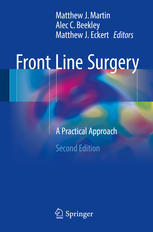Front Line Surgery: A Practical Approach 2017
دانلود کتاب پزشکی جراحی خط مقدم: یک رویکرد عملی
| نویسنده |
Alec C. Beekley,, Matthew J. Eckert, Matthew J. Martin, |
|---|
| تعداد صفحهها |
909 |
|---|---|
| نوع فایل |
|
| حجم |
37 Mb |
| سال انتشار |
2017 |
89,000 تومان
ویرایش دوم جراحی خط مقدم موفقیت نسخه اول را گسترش می دهد و بحث به روز شده ای را در مورد مدیریت عملی آسیب های رزمی رایج ارائه می دهد. اصول مدیریت جراحی الگوهای آسیب خاص، شامل طیفی از پیشرفت های تحقیقاتی اخیر در مراقبت از تروما. هر فصل به دنبال همان سازماندهی چاپ اول است. “BLUF” یا خط پایانی در مقدمه، به هر موضوع می پردازد، مرواریدهای انتقادی را برای خواننده ارائه می دهد، و به دنبال آن یک بحث متمرکز و مستقیم در مورد مدیریت، مشکلات و توصیه ها ارائه می شود. علاوه بر این، فصلهای انتخاب شده با بخشی به بحث درباره کاربرد این موضوع در عمل غیرنظامی، همانطور که بالقوه جراح امداد روستایی یا بشردوستانه با آن مواجه میشود، پایان مییابد. موضوعات جدید اضافی عبارتند از: REBOA و تکنیک های عروقی برای کنترل خونریزی، به روز رسانی در عمل انتقال خون و احیا، موقعیت های تیراندازی فعال، مدیریت ترومای روستایی در کشورهای توسعه یافته، پیشرفت در مراقبت های پیش بیمارستانی، دوره مراقبت از آسیب های رزمی تاکتیکی (TC3)، و بحث درباره نسل های جدید عوامل نازک کننده موضعی و تورنیکت ها. این اضافات وسعت و عمق مواد مربوط به جراحان نظامی را افزایش می دهد، اما همچنین باید دامنه کاربرد و علاقه به این کار را به همه جراحان غیرنظامی تروما گسترش دهد.
The second edition of Front Line Surgery expands upon the success of the first edition, providing updated discussion of practical management of commonly encountered combat injuries.This edition reflects the cutting edge of combat casualty care, refined principles of surgical management of specific injury patterns, and incorporation of the spectrum of recent research advancements in trauma care. Each chapter continues to follow the same organization as the first edition. The “BLUF”, or bottom line up front, headlines each topic, providing the critical pearls for the reader, followed by a focused and straight forward discussion of management, pitfalls, and recommendations. In addition, select chapters conclude with a section discussing the application of this topic in civilian practice, as potentially encountered by the rural or humanitarian relief surgeon. Additional new topics include: REBOA and endovascular techniques for hemorrhage control, updates in transfusion and resuscitation practice, active shooter situations, rural trauma management in developed nations, advancements in prehospital care and the Tactical Combat Casualty Care (TC3) course, and discussion of the newest generations of topical hemostatic agents and tourniquets. These additions serve to both enhance the breadth and depth of the material relevant to military surgeons, but should also further expand the applicability and interest in this work to all civilian trauma surgeons.




